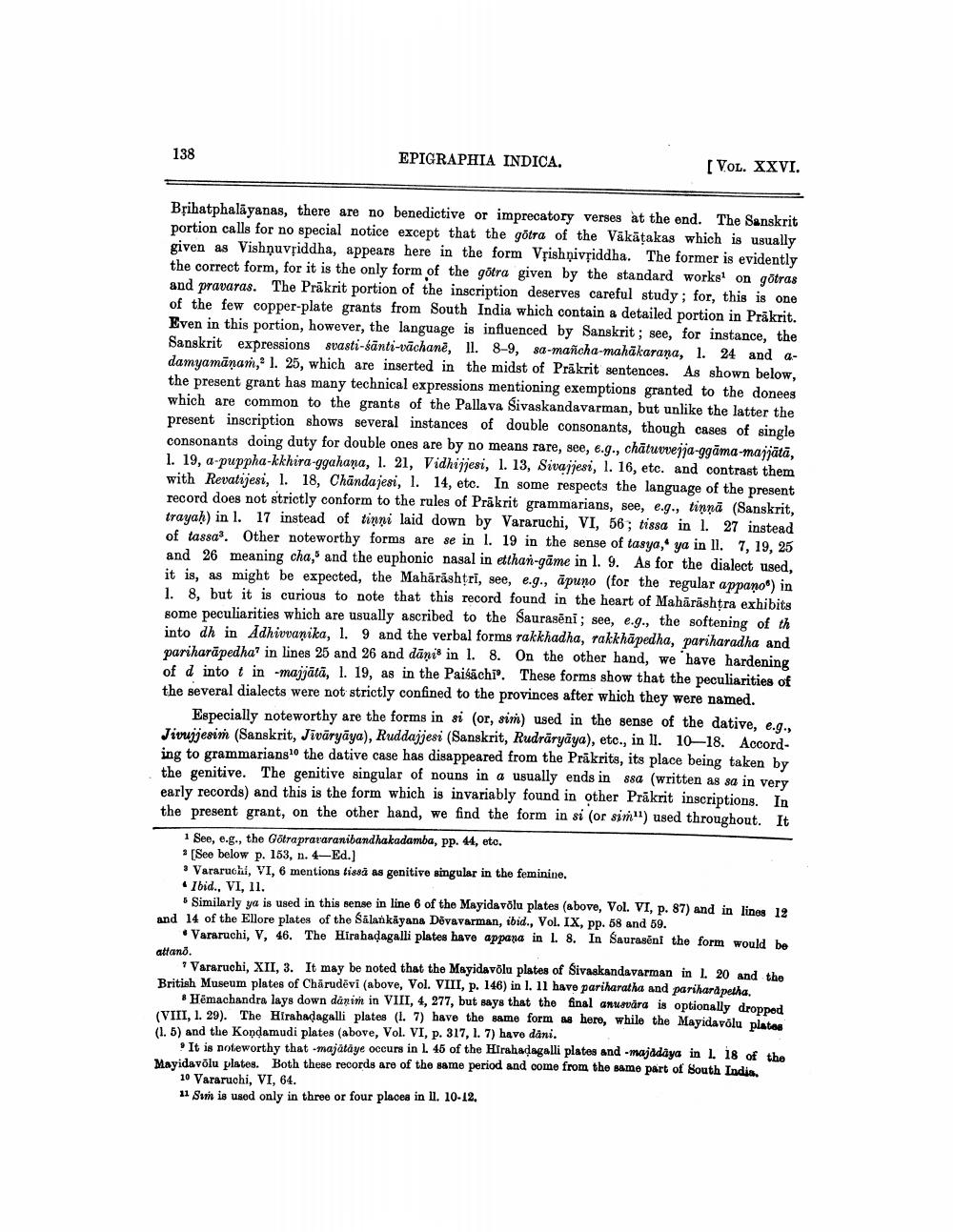________________
138
EPIGRAPHIA INDICA.
[Vol. XXVI.
Bțihatphalāyanas, there are no benedictive or imprecatory verses at the end. The Sanskrit portion calls for no special notice except that the götra of the Väkätakas which is usually given as Vishnuvriddha, appears here in the form Vrishnivsiddha. The former is evidently the correct form, for it is the only form of the götra given by the standard works' on götras and pravaras. The Präkrit portion of the inscription deserves careful study; for, this is one of the few copper-plate grants from South India which contain a detailed portion in Präkrit. Even in this portion, however, the language is influenced by Sanskrit ; see, for instance, the Sanskrit expressions svasti-śānti-vāchanē, ll. 8-9, 8a-mañcha-mahākarana, l. 24 and adamyamānam, 1. 25, which are inserted in the midst of Prākrit sentences. As shown below, the present grant has many technical expressions mentioning exemptions granted to the donees which are common to the grants of the Pallava Sivaskandavarman, but unlike the latter the present inscription shows several instances of double consonants, though cases of single consonants doing duty for double ones are by no means rare, see, e.g., chātuvvejja-ggāma-majjātā, 1. 19, a-puppha-kkhira-ggahana, l. 21, Vidhijjesi, 1. 13, Sivajjesi, 1. 16, etc. and contrast them with Revatijesi, 1. 18, Chandajesi, l. 14, etc. In some respects the language of the present record does not strictly conform to the rules of Prakrit grammarians, see, e.g., tinnā (Sanskrit, trayah) in l. 17 instead of tinni laid down by Vararuchi, VI, 56; tiesa in l. 27 instead of tassa?. Other noteworthy forms are se in l. 19 in the sense of tasya, ya in II. 7, 19, 25 and 26 meaning cha, and the euphonic nasal in etthan-gāme in l. 9. As for the dialect used, it is, as might be expected, the Mahārāshtri, see, e.g., āpuno (for the regular appano) in 1. 8, but it is curious to note that this record found in the heart of Mahārāshtra exhibits some peculiarities which are usually ascribed to the Saurasēni; see, e.g., the softening of th into dh in Adhivvanika, 1. 9 and the verbal forms rakkhadha, rakkhāpedha, pariharadha and pariharā pedha? in lines 25 and 26 and dānis in l. 8. On the other hand, we have hardening of d into t in -majjātā, l. 19, as in the Paisachi'. These forms show that the peculiarities of the several dialects were not strictly confined to the provinces after which they were named.
Especially noteworthy are the forms in si (or, sim) used in the sense of the dative, e.g., Jivujjesinh (Sanskrit, Jivāryāya), Ruddajjesi (Sanskrit, Rudrāryāya), etc., in 11. 10-18. Accord ing to grammariansło the dative case has disappeared from the Präkrits, its place being taken by the genitive. The genitive singular of nouns in a usually ends in 88a (written as sa in very early records) and this is the form which is invariably found in other Prākrit inscriptions. In the present grant, on the other hand, we find the form in si (or sin") used throughout. It
1 See, e.g., the Götra prararanibandhakadamba, pp. 44, eto. · [See below p. 153, n. 4-Ed.) • Vararuch, VI, 6 mentions tissä as genitive singular in the feminine. Ibid., VI, 11.
Similarly ya is used in this sense in line 6 of the Mayidavõlu plates (above, Vol. VI, p. 87) and in line 12 and 14 of the Ellore plates of the Salankayana Dévavarman, ibid., Vol. IX, pp. 58 and 59.
• Vararuchi, V, 46. The Hirahadagalli plates have appara in l. 8. In Saurasēni the form would be attano.
Vararuchi, XII, 3. It may be noted that the Mayidavõlu plates of Sivaskandavarman in l. 20 and the British Museum plates of Chirudēvi (above, Vol. VIII, p. 146) in l. 11 have pariharatha and parihardpetha.
Hémachandra lays down danish in VIII, 4, 277, but says that the final anusara is optionally dropped (VIII, 1. 29). The Hirahadagalli plates (1.7) have the same form sa here, while the Mayidavõlu plates (1. 5) and the Kondamudi plates (above, Vol. VI, p. 317, 1. 7) havo dani.
It is noteworthy that -majatäye occurs in L. 45 of the Hirahadegalli plates and majadaya in I. 18 of the Mayidavõlu plates. Both these records are of the same period and come from the same part of South India.
10 Vararuchi, VI, 64. 11 Sm is used only in three or four placea in II. 10-12




